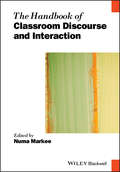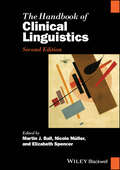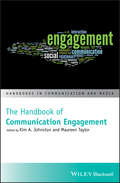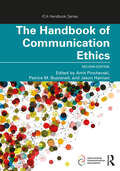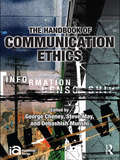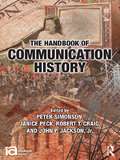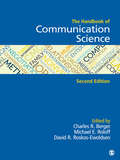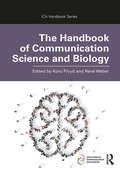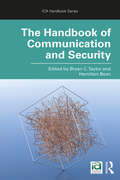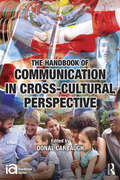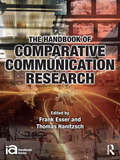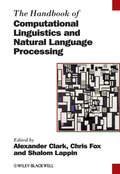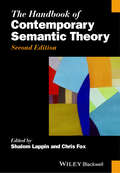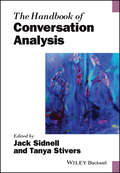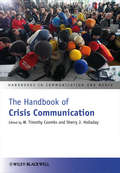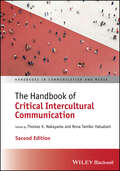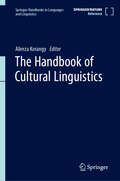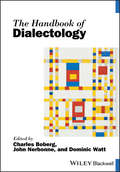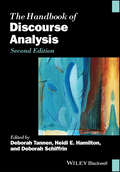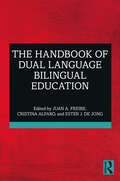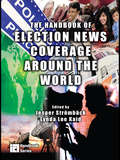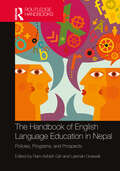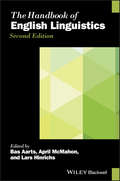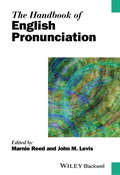- Table View
- List View
The Handbook of Classroom Discourse and Interaction (Blackwell Handbooks in Linguistics #115)
by Numa MarkeeOffering an interdisciplinary approach, The Handbook of Classroom Discourse and Interaction presents a series of contributions written by educators and applied linguists that explores the latest research methodologies and theories related to classroom language. • Organized to facilitate a critical understanding of how and why various research traditions differ and how they overlap theoretically and methodologically • Discusses key issues in the future development of research in critical areas of education and applied linguistics • Provides empirically-based analysis of classroom talk to illustrate theoretical claims and methodologies • Includes multimodal transcripts, an emerging trend in education and applied linguistics, particularly in conversation analysis and sociocultural theory
The Handbook of Clinical Linguistics (Blackwell Handbooks in Linguistics)
by Elizabeth Spencer Martin J. Ball Nicole MüllerThe new edition of the leading reference work on Clinical Linguistics, fully updated with new research and developments in the field The Handbook of Clinical Linguistics, Second Edition provides a timely and authoritative survey of this interdisciplinary field, exploring the application of linguistic theory and method to the study of speech and language disorders. Containing 42 in-depth chapters by an international panel of established and rising scholars, this classic volume addresses a wide range of pathologies while offering valuable insights into key theory and research, multilingual and cross-linguistics factors, analysis and assessment methods, and more. Now in its second edition, The Handbook of Clinical Linguistics features nine entirely new chapters on clinical corpus linguistics, multimodal analysis, cognition and language, the linguistics of sign languages, clinical phonotactics, typical and nontypical phonological development, clinical phonology and phonological assessment, and two chapters on instrumental analysis of voice and speech production. Revised and expanded chapters incorporate new research in clinical linguistics and place greater emphasis on specific speech disorders, connections to literacy, and multilingualism. This invaluable reference works: Reflects the latest developments in new research and data, as well as changing perspectives about the priorities and future of the field Features new and revised chapters throughout, many with new authors or authorial teams Offers well-rounded coverage of the major areas of the speech sciences in the study of communication disorders Discusses how mainstream theories and descriptions of language are influenced by clinical researchBuilding on the success of the first edition, The Handbook of Clinical Linguistics, Second Edition, is an indispensable resource for researchers and advanced students across all areas of speech-language sciences, including speech disorders, speech pathology, speech therapy, communication disorders, cognitive linguistics, and neurolinguistics.
The Handbook of Communication Engagement (Handbooks in Communication and Media)
by Maureen Taylor Kim A. JohnstonA comprehensive volume that offers the most current thinking on the practice and theory of engagement With contributions from an international panel of leaders representing diverse academic and professional fields The Handbook of Communication Engagement brings together in one volume writings on both the theory and practice of engagement in today’s organizations and societies. The expert contributors explore the philosophical, theoretical, and applied concepts of communication engagement as it pertains to building interaction and connections in a globalized, networked society. The Handbook of Communication Engagement is comprehensive in scope with case studies of engagement from various disciplines including public relations, marketing, advertising, employee relations, education, public diplomacy, and politics. The authors advance the current thinking in engagement theory, strategy, and practice and provide a review of foundational and emerging research in engagement topics. The Handbook of Communication Engagement is an important text that: Provides an overview of the foundations and philosophies of engagement Identifies the contexts of engagement relating to specific areas across government and corporations, including CSR, consumer, activism, diplomacy, digital, and social impact Includes examples of contemporary engagement practice Presents applications of engagement and technology Offers insights on the future directions of engagement The Handbook of Communication Engagement offers an essential reference for advanced undergraduate, graduate students, practitioners and scholars from communication, media, advertising, public relations, public policy, and public diplomacy areas. The volume contains a compendium of the writings on the most recent advances on the theory and practice of engagement. Winner of the 2018 PRIDE Award for Innovation, Development, and Educational Achievement from the Public Relations Division of the National Communication Association.
The Handbook of Communication Ethics (ICA Handbook Series)
by Amit Pinchevski Patrice M. Buzzanell Jason HannanThe second edition of this handbook offers a thoroughly updated overview of the different approaches and perspectives in communication ethics today.Extending the path paved by its predecessor, this handbook includes new issues and concerns that have emerged in the interim—from environmentalism to artificial intelligence, from disability studies to fake news. It also features a new structure, comprised of three sections representing a wide array of communication ethics: traditions, contexts, and debates. Rather than focusing exclusively on a subset of ethics (such as interpersonal communication, rhetoric, or journalism, as do other handbooks of ethics in communication), this collection provides a valuable resource for those who seek a broader basis on which to study communication ethics.This handbook is a must-read for faculty, graduate students, and advanced undergraduate students in all areas of communication studies, as well as in neighboring disciplines such as rhetoric, media studies, sociology, political science, cultural studies, and science and technology studies.
The Handbook of Communication Ethics (ICA Handbook Series)
by George CheneyThe Handbook of Communication Ethics serves as a comprehensive guide to the study of communication and ethics. It brings together analyses and applications based on recognized ethical theories as well as those outside the traditional domain of ethics but which engage important questions of power, equality, and justice. The work herein encourages readers to make important connections between matters of social justice and ethical theory. This volume makes an unparalleled contribution to the literature of communication studies, through consolidating knowledge about the multiple relationships between communication and ethics; by systematically treating areas of application; and by introducing explicit and implicit examinations of communication ethics to one another. The Handbook takes an international approach, analyzing diverse cultural contexts and comparative assessments. The chapters in this volume cover a wide range of theoretical perspectives on communication and ethics, including feminist, postmodern and postcolonial; engage with communication contexts such as interpersonal and small group communication, journalism, new media, visual communication, public relations, and marketing; and explore contemporary issues such as democracy, religion, secularism, the environment, trade, law, and economics. The chapters also consider the dialectical tensions between theory and practice; academic and popular discourses; universalism and particularism; the global and the local; and rationality and emotion. An invaluable resource for scholars in communication and related disciplines, the Handbook also serves as a main point of reference in graduate and upper-division undergraduate courses in communication and ethics. It stands as an exceptionally comprehensive resource for the study of communication and ethics.
The Handbook of Communication History (ICA Handbook Series)
by Jr. Janice Peck Peter Simonson Robert T. Craig John P. JacksonThe Handbook of Communication History addresses central ideas, social practices, and media of communication as they have developed across time, cultures, and world geographical regions. It attends to both the varieties of communication in world history and the historical investigation of those forms in communication and media studies. The Handbook editors view communication as encompassing patterns, processes, and performances of social interaction, symbolic production, material exchange, institutional formation, social praxis, and discourse. As such, the history of communication cuts across social, cultural, intellectual, political, technological, institutional, and economic history. The volume examines the history of communication history; the history of ideas of communication; the history of communication media; and the history of the field of communication. Readers will explore the history of the object under consideration (relevant practices, media, and ideas), review its manifestations in different regions and cultures (comparative dimensions), and orient toward current thinking and historical research on the topic (current state of the field). As a whole, the volume gathers disparate strands of communication history into one volume, offering an accessible and panoramic view of the development of communication over time and geographical places, and providing a catalyst to further work in communication history.
The Handbook of Communication Science
by Charles R. Berger Michael E. Roloff David R. EwoldsenThis revision of a classic volume presents state-of-the-art reviews of established and emerging areas of communication science and provides an intellectual compass that points the way to future theorizing about communication processes. In this Second Edition of The Handbook of Communication Science, editors Charles R. Berger, Michael E. Roloff, and David Roskos-Ewoldsen bring together an impressive array of communication scholars to explore and synthesize the varying perspectives and approaches within the dynamic field of communication science. After first addressing the methods of research and the history of the field, the Handbook then examines the levels of analysis in communication (individual to macro-social), the functions of communication (such as socialization and persuasion), and the contexts in which communication occurs (such as couples, families, organizations, and mass media). Key Features: Draws on the scholarship and expertise of leading communication scholars who explore different aspects of the field Covers all facets of communication science, from the historical and theoretical to the practical and applied Covers the latest theoretical developments in the field, as well as alternative methodologies and levels of analysis Explores key communication contexts of the 21st century, including interpersonal dimensions of health communication, the scientific investigation of marital and family communication, and computer-mediated communication Includes incisive analyses, literature reviews, bibliographies, and suggestions for future research The Handbook of Communication Science, Second Edition, is an essential reference resource for scholars, practitioners, and students. It is appropriate for upper-level undergraduate or graduate courses in Communication and Media Studies and Mass Communication.
The Handbook of Communication Science and Biology (ICA Handbook Series)
by René Weber Kory FloydThe Handbook of Communication Science and Biology charts the state of the art in the field, describing relevant areas of communication studies where a biological approach has been successfully applied. The book synthesizes theoretical and empirical development in this area thus far and proposes a roadmap for future research. As the biological approach to understanding communication has grown, one challenge has been the separate evolution of research focused on media use and effects and research focused on interpersonal and organizational communication, often with little intellectual conversation between the two areas. The Handbook of Communication Science and Biology is the only book to bridge the gap between media studies and human communication, spurring new work in both areas of focus. With contributions from the field’s foremost scholars around the globe, this unique book serves as a seminal resource for the training of the current and next generation of communication scientists, and will be of particular interest to media and psychology scholars as well.
The Handbook of Communication and Security (ICA Handbook Series)
by Bryan C. Taylor Hamilton BeanThe Handbook of Communication and Security provides a comprehensive collection and synthesis of communication scholarship that engages security at multiple levels, including theoretical vs. practical, international vs. domestic, and public vs. private. The handbook includes chapters that leverage communication-based concepts and theories to illuminate and influence contemporary security conditions. Collectively, these chapters foreground and analyze the role of communication in shaping the economic, technological, and cultural contexts of security in the 21st century. This book is ideal for advanced undergraduate and postgraduate students and scholars in the numerous subfields of communication and security studies.
The Handbook of Communication in Cross-cultural Perspective (ICA Handbook Series)
by Donal CarbaughThis handbook brings together 26 ethnographic research reports from around the world about communication. The studies explore 13 languages from 17 countries across 6 continents. Together, the studies examine, through cultural analyses, communication practices in cross-cultural perspective. In doing so, and as a global community of scholars, the studies explore the diversity in ways communication is understood around the world, examine specific cultural traditions in the study of communication, and thus inform readers about the range of ways communication is understood around the world. Some of the communication practices explored include complaining, hate speech, irreverence, respect, and uses of the mobile phone. The focus of the handbook, however, is dual in that it brings into view both communication as an academic discipline and its use to unveil culturally situated practices. By attending to communication in these ways, as a discipline and a specific practice, the handbook is focused on, and will be an authoritative resource for understanding communication in cross-cultural perspective. Designed at the nexus of various intellectual traditions such as the ethnography of communication, linguistic ethnography, and cultural approaches to discourse, the handbook employs, then, a general approach which, when used, understands communication in its particular cultural scenes and communities.
The Handbook of Comparative Communication Research (ICA Handbook Series)
by Frank Esser Thomas HanitzschThe Handbook of Comparative Communication Research aims to provide a comprehensive understanding of comparative communication research. It fills an obvious gap in the literature and offers an extensive and interdisciplinary discussion of the general approach of comparative research, its prospect and problems as well as its applications in crucial sub-fields of communications. The first part of the volume charts the state of the art in the field; the second section introduces relevant areas of communication studies where the comparative approach has been successfully applied in recent years; the third part offers an analytical review of conceptual and methodological issues; and the last section proposes a roadmap for future research.
The Handbook of Computational Linguistics and Natural Language Processing (Blackwell Handbooks in Linguistics #57)
by Alexander ClarkThis comprehensive reference work provides an overview of the concepts, methodologies, and applications in computational linguistics and natural language processing (NLP). Features contributions by the top researchers in the field, reflecting the work that is driving the discipline forward Includes an introduction to the major theoretical issues in these fields, as well as the central engineering applications that the work has produced Presents the major developments in an accessible way, explaining the close connection between scientific understanding of the computational properties of natural language and the creation of effective language technologies Serves as an invaluable state-of-the-art reference source for computational linguists and software engineers developing NLP applications in industrial research and development labs of software companies
The Handbook of Conflict and Peace Communication (Global Handbooks in Media and Communication Research)
by Sudeshna RoyAn incisive collection of essays highlighting conflict and peace issues in the Global South, with coverage of theory, method, mediated, case-oriented, and innovative approaches In Handbook of Conflict and Peace Communication, renowned communication and media scholar Dr. Sudeshna Roy delivers an authoritative exploration of a variety of critical conflicts in the world and a spectrum of approaches to peace communication. This book offers an in-depth view of how intricate and intractable conflicts can be and how the communicative aspects of conflict are equally challenging. The author reviews and guides readers through classic and contemporary analysis in the field, providing a truly interdisciplinary work. Handbook of Conflict and Peace Communication is divided into five navigable sections—Theory Development, Method Development, Traditional/Digital Media and Peace and Conflict, Case Studies, and Innovative Approaches – that help illuminate workable and innovative peace communication strategies relevant to today’s conflicts. Readers will also find: Informative contributions from a collection of outstanding scholars, practitioners, and activists Comprehensive explorations of past conflict communication theory in the context of contemporary theory Practical tools to navigate complex local and global conflicts In-depth examinations of strategies of peace communication from the margins that acknowledge and elevate solutions for and from the most vulnerablePerfect for undergraduate and graduate students, scholars, and practitioners of peace and conflict studies, media studies, intercultural communication, human rights, and social justice, Handbook of Conflict and Peace Communication will also earn a place in the libraries of interdisciplinary studies involving philosophy, anthropology, political science, history, geography, economics, psychology, and others.
The Handbook of Contemporary Semantic Theory (Blackwell Handbooks in Linguistics)
by Chris Fox Shalom LappinThe second edition of The Handbook of Contemporary Semantic Theory presents a comprehensive introduction to cutting-edge research in contemporary theoretical and computational semantics. Features completely new content from the first edition of The Handbook of Contemporary Semantic Theory Features contributions by leading semanticists, who introduce core areas of contemporary semantic research, while discussing current research Suitable for graduate students for courses in semantic theory and for advanced researchers as an introduction to current theoretical work
The Handbook of Conversation Analysis
by Jack Sidnell Tanya StiversPresenting a comprehensive, state-of-the-art overview of theoretical and descriptive research in the field, The Handbook of Conversation Analysis brings together contributions by leading international experts to provide an invaluable information resource and reference for scholars of social interaction across the areas of conversation analysis, discourse analysis, linguistic anthropology, interpersonal communication, discursive psychology and sociolinguistics. Ideal as an introduction to the field for upper level undergraduates and as an in-depth review of the latest developments for graduate level students and established scholarsFive sections outline the history and theory, methods, fundamental concepts, and core contexts in the study of conversation, as well as topics central to conversation analysisWritten by international conversation analysis experts, the book covers a wide range of topics and disciplines, from reviewing underlying structures of conversation, to describing conversation analysis' relationship to anthropology, communication, linguistics, psychology, and sociology
The Handbook of Crisis Communication
by W. Timothy Coombs Sherry J. HolladayWritten as a tool for both researchers and communication managers, the Handbook of Crisis Communication is a comprehensive examination of the latest research, methods, and critical issues in crisis communication. Includes in-depth analyses of well-known case studies in crisis communication, from terrorist attacks to Hurricane KatrinaExplores the key emerging areas of new technology and global crisis communicationProvides a starting point for developing crisis communication as a distinctive field research rather than as a sub-discipline of public relations or corporate communication
The Handbook of Critical Intercultural Communication (Handbooks in Communication and Media)
by Thomas K. Nakayama Rona Tamiko HalualaniAn up-to-date and comprehensive resource for scholars and students of critical intercultural communication studies In the newly revised second edition of The Handbook of Critical Intercultural Communication, a lineup of outstanding critical researchers delivers a one-stop collection of contemporary and relevant readings that define, delineate, and inhabit what it means to ‘do critical intercultural communication.’ In this handbook, you will uncover the latest research and contributions from leading scholars in the field, covering core theoretical, methodological, and applied works that give shape to the arena of critical intercultural communication studies. The handbook's contents scaffold up from historical revisitings to theorizings to inquiry and methodologies and critical projects and applications. This work invites readers to deeply immerse themselves in and reflect upon the thematic threads shared within and across each chapter. Readers will also find: Newly included instructors' resources, including reading assignments, discussion guides, exercises, and syllabi Current and state-of-the-art essays introducing the book and delineating each section Brand-new sections on critical inquiry practices and methodologies and contemporary critical intercultural projects and topics such as settler colonialism, intersectionalities, queerness, race, identities, critical intercultural pedagogy, migration, ecologies, critical futures, and more Perfect for scholars, researchers, and students of intercultural communication, intercultural studies, critical communication, and critical cultural studies, The Handbook of Critical Intercultural Communication, 2nd edition, stands as the premier resource for anyone interested in the dynamic and ever evolving field of study and praxis: critical intercultural communication studies.
The Handbook of Cultural Linguistics (Springer Handbooks in Languages and Linguistics)
by Alireza KorangyBringing together a wide selection of work on cultural linguistics and pragmatics, this comprehensive handbook offers global, comparative insights into the field. Diversity does not always imply differences, but it also offers insights into surprising similarities and parallels when it comes to expressions. By the same token, this collection shows that when we see that linguistic differences, when they exist, stem from not merely language, but from the cultural and historical context that cultivates and nurtures them. Within that paradigm, then, this handbook locates the importance of philosophy, religion (or even the lack thereof), political affiliations, and so on, in forming expressions. In addition, comparisons with other models of cultural linguistics are undertaken. These trends provide readers with a comprehensive introduction to issues in cultural linguistics, addressing the peculiarities of the field under the rubric of localized studies, and speaking to the possibilities that exist in interpretation of what metaphors are. The book highlights the complexities that are so tightly interwoven into the fabric of every word and a sentence, across cultures and linguistic traditions. A must-have collection for anthropologists, philosophers, linguists, philologists, theoreticians, rhetoricians, and scholars of poetics, this is the one-stop reference in cultural linguistics.
The Handbook of Dialectology (Blackwell Handbooks in Linguistics)
by Charles Boberg Dominic Watt John NerbonneThe Handbook of Dialectology provides an authoritative, up-to-date and unusually broad account of the study of dialect, in one volume. Each chapter reviews essential research, and offers a critical discussion of the past, present and future development of the area. The volume is based on state-of-the-art research in dialectology around the world, providing the most current work available with an unusually broad scope of topics Provides a practical guide to the many methodological and statistical issues surrounding the collection and analysis of dialect data Offers summaries of dialect variation in the world’s most widely spoken and commonly studied languages, including several non-European languages that have traditionally received less attention in general discussions of dialectology Reviews the intellectual development of the field, including its main theoretical schools of thought and research traditions, both academic and applied The editors are well known and highly respected, with a deep knowledge of this vast field of inquiry
The Handbook of Discourse Analysis (Blackwell Handbooks in Linguistics #17)
by Deborah Tannen Deborah Schiffrin Heidi E. HamiltonThe second edition of the highly successful Handbook of Discourse Analysis has been expanded and thoroughly updated to reflect the very latest research to have developed since the original publication, including new theoretical paradigms and discourse-analytic models, in an authoritative two-volume set. Twenty new chapters highlight emerging trends and the latest areas of research Contributions reflect the range, depth, and richness of current research in the field Chapters are written by internationally-recognized leaders in their respective fields, constituting a Who’s Who of Discourse Analysis A vital resource for scholars and students in discourse studies as well as for researchers in related fields who seek authoritative overviews of discourse analytic issues, theories, and methods
The Handbook of Dual Language Bilingual Education
by Juan A. Freire Cristina Alfaro de Jong, Ester JThis handbook presents a state-of-the-art overview of dual language bilingual education (DLBE) research, programs, pedagogy, and practice. Organized around four sections—theoretical foundations; key issues and trends; school-based practices; and teacher and administrator preparation—the volume comprehensively addresses major and emerging topics in the field. With contributions from expert scholars, the handbook highlights programs that honor the assets of language-minoritized and marginalized students and provides empirically grounded guidance for asset-based instruction. Chapters cover historical and policy considerations, leadership, family relations, professional development, community partnerships, race, class, gender, and more. Synthesizing major issues, discussing central themes and advancing policy and practice, this handbook is a seminal volume and definitive reference text in bilingual/second language education.
The Handbook of Election News Coverage Around the World (ICA Handbook Series)
by Jesper Strömbäck Lynda Lee KaidThe Handbook of Election Coverage Around the World focuses on the news coverage of national elections in democracies around the globe. It brings together and compares election news coverage within a single framework, offering a systematic consideration of various factors. Considering the prominence and power of the press in the election process, this volume will offer unique breadth in its global consideration of the topic. The volume will appeal to scholars in political communication, political science, mass media and society, and others studying elections and media coverage around the world.
The Handbook of English Language Education in Nepal: Policies, Programs, and Prospects
by Ram Ashish Giri and Laxman GnawaliThis book takes an interdisciplinary approach to explore wide-ranging topics from applied linguistics, education, sociology, political science, and cultural studies. It presents a comprehensive overview of English language education since its importation to Nepal.This volume covers English language education (ELE) politics and policy, theories and pedagogies, English as a medium of instruction, English teachers’ professional development, multilingualism and linguistic ecology, perspectives on equity, diversity and inclusion, as well as ELT and technology. Comprising scholarly discussions on emerging ELE issues in contemporary Nepal, the chapters explore various aspects of theoretical, and pedagogical considerations of ELE. While delving into the growing future of English in Nepal, it also presents analytical case studies of its controversial present and past practices. It sheds light on its development, shifting paradigms and present state of affairs, as well as the status of English in conjunction with the national language, Nepali and other Indigenous languages.This book will be useful to students, researchers and teachers of education, linguistics, and teacher training institutions. It will be an essential read for those involved in English language education, applied linguistics, EIL/WE/ELF, ESL/TESOL/ELT and TEFL, as well as for teachers, teacher educators, teacher trainees and international aid organisations.
The Handbook of English Linguistics (Blackwell Handbooks in Linguistics #15)
by Bas Aarts April McMahon Lars HinrichsSecond edition of this popular Handbook bringing together stimulating discussions of core English linguistics topics in a single, authoritative volume—includes numerous new and thoroughly updated chapters The second edition of the popular Handbook of English Linguistics brings together stimulating discussions of the core topics in English linguistics in a single, authoritative volume. Written by an international team of experts, the chapters cover syntax, methodology, phonetics and phonology, lexis and morphology, variation, stylistics, and discourse, and also provide discussions of theoretical and descriptive research in the field. The revised edition includes new and updated chapters on English Corpus Linguistics, experimental approaches, complements and adjuncts, English phonology and morphology, lexicography, and more. In-depth yet accessible chapters introduce key areas of English linguistics, discuss relevant research, and suggest future research directions. An important academic contribution to the field, this book: Presents thirty-two in-depth, yet accessible, chapters that discuss new research findings across the field, written by both established and emerging scholars from around the world Builds upon the very successful first edition, published in 2006 Incorporates new trends in English linguistics, including digital research methods and theoretical advances in all subfields Suggests future research directions The Handbook of English Linguistics, 2nd Edition is an essential reference work for researchers and students working in the field of English language and linguistics.
The Handbook of English Pronunciation (Blackwell Handbooks in Linguistics)
by Marnie Reed John LevisThe Handbook of English Pronunciation presents a comprehensive exploration of English pronunciation with essential topics for applied linguistics researchers and teachers, including language acquisition, varieties of English, historical perspectives, accent’s changing role, and connections to discourse, technology, and pedagogy. Provides thorough descriptions of all elements of English pronunciation Features contributions from a global list of authors, reflecting the finest scholarship available Explores a careful balance of issues and topics important to both researchers and teachers Provides a historical understanding of the importance of pronunciation and examines some of the major ways English is pronounced today throughout the world Considers practical concerns about how research and practice interact in teaching pronunciation in the classroom
